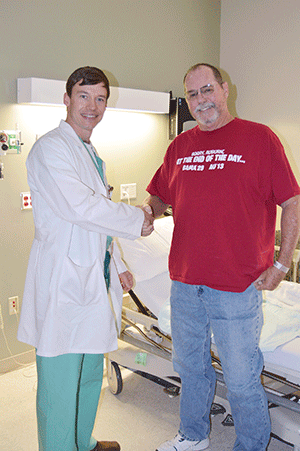GOODBYE, BACK PAIN?
Published 12:55 am Saturday, January 16, 2016
New procedure at ARH offers relief to chronic pain sufferers
Steve Sharpe had struggled with chronic back pain until he became one of the first patients to undergo a procedure now available at Andalusia Regional Hospital.
Dr. Brad Thomas practices radiology primarily in Montgomery, but also has established an interventional spine practice at ARH.
“We treat patients that have low back pain caused by nerve inflammation,” he explained.

Dr. Brad Thomas has performed two radio frequency nerve ablations for Steve Sharpe. A week after his first procedure – and less than two hours after the second – he was all smiles and pleased with the results.
Recently, he began treating patients locally for pain associated with inflammation of the facet joints of the spine using radio frequency nerve ablation.
“The pain can be debilitating to the patients,” Thomas said.
Thomas said when he diagnosed Sharpe with facet-related pain, he had been treated with steroid injections and nerve blocks.
“We determined he was a candidate for radio frequency nerve ablation,” Thomas said. “What that does, is if we can uncouple the nerve from the painful joint, it will stop sending a ‘pain’ signal to the brain.
“We brought him in last week to do one side of facet joints, and he’s back today to do the other side,” Thomas said in early December. “He has had marked improvement and is excited about having the procedure on the other side.”
The outpatient procedure is minimally invasive, Thomas said.
“What we are doing is taking away the nerve supply to the joints,” he said. “Recovery is only a couple of hours.”
Some nerves do reconnect, Thomas said. However, the procedure generally provides relief for approximately 18 to 24 months, whereas other interventions only last one or two months. He also likes to minimize steroid injections for any patient,
“This will give him a longer lasting benefit,” Thomas said.
In the procedure, physicians use x-ray guidance to direct a special radiofrequency needle. To make sure the needle is in the right place, Thomas said, the physician stimulates the nerve to see if it reproduces the usual pain.
“This is a safety test to make sure we aren’t damaging the wrong nerve,” he said.
“We then use local anesthetic to numb the nerve,” Thomas said.
The radiofrequency is then sent into the probe, which heats the tissue.
“We heat the tissue to 80 degrees Celsius for one minute,” he explained. “The whole time, we are monitoring vital signs.”
Thomas has been treating patients at ARH with other interventional spine procedures for five years, but said he is pleased to move to the next level.
“This is something more advanced to offer patients who have debilitating spine pain,” he said. “It’s not for everybody. But there is a subset of patients who qualify for whom other conservative therapy has failed.”
Thomas said he treats spine pain with interventional procedures.
“ I do not have a clinic, and I do not prescribe narcotics,” he said. “I rarely have people ask for it.
“The primary physician is still the quarterback of a patient’s care. He knows a patient’s entire physical ailments. After a procedure, we send patients back to their primary physicians.”
Many times, Thomas said, the interventions he performs can get patients “over the hump” as they wait for their bodies to heal.
“I’ve had several patients, for instance, with a disc herniation. Some can’t tolerate getting out of bed. Others get along in life with three or four steroid injections.
“The body can absorb and heal that herniated disc,” he said. “If we can help the patient push through, with the help of injections, they can wait it out. With physical therapy and steroid injections, it will give the body a chance to heal and that’s a great situation to hope for.”
ARH CEO John Yanes said partnering with Dr. Thomas and the Radiology Group is just one way the local hospital ensures that patents can get appropriate treatment.
“As a society, we are grappling with the scourge of pain meds,” Yanes said. “Many time, it is because the patient is not appropriately diagnosed. We know that benefit comes to this community.”
“This is one more way we are keeping patients close to home,” Yanes said.
Thomas practices with the Radiology Group, P.A. in Montgomery.
He earned his medical degree from the University of Alabama School of Medicine, and completed his internship at Baptist Health Systems in Birmingham. Dr. Thomas completed his residency at Vanderbilt University Medical Center and served as chief resident during the 2006 academic year. He also completed his fellowship in Neuroradiology at Vanderbilt University Medical Center. He is board-certified radiologist by the American Board of Radiology.




